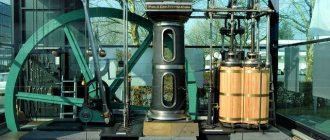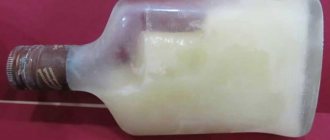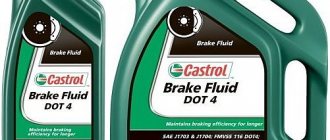Mineral motor oil has a mineral base because it is a product of petroleum origin and is produced by distilling fuel oil. It is characterized by instability of its characteristics and a high degree of evaporation. Mineral oils can also be produced from industrial crops.
Since the technology for producing mineral water is relatively simple, the price of such oils is significantly lower than that of synthetic oils.
Mineral oils are practically never found in their natural pure form, since they can only have the necessary lubricating properties at “room” temperatures without heavy loads. Therefore, in internal combustion engines they are used only with stabilizing additives to make the oils more efficient.
Such additives are added to the base oil and help increase the anti-corrosion, anti-wear, and detergent properties of mineral motor oils. After all, the performance characteristics of oils of mineral origin do not allow them to withstand too high temperatures; it quickly thickens in the cold , and when boiling, it clogs the engine with combustion products. It is precisely because of these characteristics that mineral oil for cars, in addition to the base itself, contains about 12% additives. High-quality mineral oil must be made from good petroleum products and have a high degree of purification.
Composition of mineral oil
“Mineral water”, which is used as a lubricant, has the following composition :
- Alkaline and cyclic paraffins.
- Cyclane - 75-80%, aromatic - 10-15% and cyclane-aromatic hydrocarbons - 5-15 percent.
- Minor amount of unsaturated and alkane hydrocarbons.
Mineral motor oils also contain oxygen and sulfur derivatives of hydrocarbons, as well as resinous asphalt compounds. But all these compounds are not included in the basis of lubricating oils for engines in the quantities described above, because they undergo deep cleaning.
In addition to the mineral base itself of varying viscosity, the oil also contains a different set of additives, which, in addition to improving basic performance indicators, are also a disadvantage. Since high temperatures have a detrimental effect on them, additives burn out relatively quickly , as a result of which the oil changes its properties. This especially affects engines with high mileage.
For optimal operation of the internal combustion engine, it is recommended to replace mineral oil after a run of 5–6 thousand km, before it has yet lost its properties.
Composition, capacity of lubricants
Based on consistency and physical properties, mineral coatings are divided into 3 groups:
- oils;
- plastic, having a creamy consistency;
- solid.
The basis for the manufacture of mineral lubricants is mineral oil. Its content is 80-10%. The remainder is thickeners and additives added in a 2:1 ratio. The most common thickeners are calcium and sodium. Instead, solid hydrocarbons, for example, paraffin, beryllium soaps, can be added.
Oils for the production of mineral coatings are obtained from oil refinery waste. The process is as follows: after atmospheric distillation of oil, what remains is gasoline, kerosene, diesel fuel and the remainder - fuel oil. Further, in the process of vacuum distillation, motor fuels, oils, and oil tar are obtained from fuel oil. To obtain high-quality lubricant without impurities, oils are purified with sulfuric acid and alkalis. Various additives help to obtain a qualitatively new product with enhanced properties.
Mineral lubricants can be purchased as:
- aerosol;
- grease.
Anti-corrosion mineral oil is sold in aerosols, suitable for household use, electromechanical equipment, and special equipment.
Plastic materials for industrial use are sold in large volumes, usually in buckets with a capacity of 20 liters or more, barrels of 180 kg.
Oils and plastic coatings can be used in production. The choice of material depends on the application.
The advantages of lubricants are their ability to maintain shape and density under light loads. As the workload increases, they become a highly viscous liquid.
Mineral oil viscosity
Not only in mineral oils, but also in other oils (synthetic, semi-synthetic), viscosity is the most important characteristic. In motor oil, as in most fuels and lubricants, viscosity changes depending on temperature (the lower it is, the more viscous the oil becomes and vice versa). For normal engine operation, it should not be higher or lower than a certain value, that is, when starting a cold engine at sub-zero temperatures, the oil viscosity should not be high. And in the hot season, when starting a heated engine, the oil should not be very liquid in order to provide a strong film and the necessary pressure between the rubbing parts.
Engine oil has a certain viscosity index. This indicator characterizes the dependence of viscosity on changing temperature.
The oil viscosity index is a dimensionless quantity (just a number) that is not measured in any units. This number shows the “degree of dilution” of the oil, and the higher this index, the wider the temperature range at which normal engine operation .
Graph of the dependence of the kinematic viscosity of mineral oil on temperature.
In mineral oils that do not contain viscosity additives, the index value ranges from 85 to 100, and with additives it can be up to 120. A low viscosity index indicates poor engine starting at low ambient temperatures and poor wear protection at high temperatures.
According to the SAE standard , the main viscosity indicators (types) of mineral-based oils can be as follows: 10W-30, 10W-40 and 15W-40. These 2 numbers, separated by the letter W, indicate the temperature range in which the oil can be used. That is, its viscosity, at the lower temperature threshold and at the upper one, should ensure normal operation of the engine.
For example, if it is 10W40, then its temperature range of application is from -20 to +35 °C Celsius, and at +100 °C its viscosity should be 12.5–16.3 cSt. Thus, when selecting a lubricant for an engine, you need to understand that in mineral motor oils the viscosity changes in inverse proportion to the temperature - the higher the oil temperature, the lower its viscosity becomes and vice versa. The nature of this dependence differs depending on what raw materials and what method were used in the production of oil.
About oil viscosity additives
The thickness of the oil film between the rubbing surfaces depends on the viscosity of the oil. And this, in turn, affects the operation of the engine and its service life. As we discussed above with the temperature dependence of viscosity, high viscosity is accompanied by a large oil film thickness, and as the oil viscosity decreases, the film thickness becomes smaller . Therefore, in order to prevent wear of some parts (camshaft cam - tappet), in addition to viscous additives, it is necessary to add extreme pressure additives to the mineral water, since in such an assembly it becomes impossible to create an oil film of the required thickness.
Oils from different manufacturers contain different additive packages that may be incompatible.
Additional characteristics of mineral oil
In addition to the main characteristics of mineral oil, there are several others.
- Flash point is an indicator of low-boiling fractions. This indicator determines the volatility of the oil during operation. Low-quality oils have a low flash point, which contributes to high oil consumption.
- Alkaline number - determines the ability of the oil to neutralize harmful acids and counteract deposits due to active additives.
- Pour point is an indicator that determines the temperature at which mineral oil solidifies and loses fluidity due to paraffin crystallization.
- Acid number - indicates the presence of oil oxidation products.
Other operating parameters of mineral water
Mineral water and synthetics in cold weather
An important advantage of mineral oil for a car engine is its affordable price, but you must remember the disadvantages of the lubricant. Compliance with the rules of fluid operation will improve the operation of the internal combustion engine, extending its service life. Properly selected lubricant will protect mechanisms from corrosion and wear.
Additional characteristics of mineral engine oil include:
- Flash point is an indicator of low-boiling fractions. The volatility of the oil during operation depends on it. Low-quality fluids have a low flash point, resulting in increased lubricant consumption.
- The ability of a liquid to neutralize harmful acids and counteract deposits due to the content of active additives in the composition depends on the alkaline number.
- Pour point. This is another important parameter of mineral oil, which determines the pour point of the oil and the deterioration of its fluidity due to paraffin crystallization.
- Acid number – the content of oxidation products in the lubricant composition depends on it.
Disadvantages and advantages of mineral motor oil
The main disadvantages of mineral motor oil include instability of parameters at different temperatures, as well as rapid oxidation and destruction (burnout of additives at high temperatures), which negatively affects engine performance. And the only advantage is the price .
Mineral oils are, for the most part, used as mechanical lubricants, although hydrocracking oils , obtained by distillation and deep refining with the addition of an additive package, are still used by modern car brands (for example, Subaru) as engine lubricants. Such mineral oil turns out to be close in quality to “synthetic”, but ages faster, losing its properties. Therefore, you have to change the oil twice as often.
The car manufacturer's recommendations for oil use can be found in the technical documentation. Although they often try to pour only synthetic oil, which is an order of magnitude superior to mineral oil, however, the price is also much higher. Ordinary mineral oil is intended for older types of engines , or for engines with high mileage and only in the warm season. The specific purpose is determined by classification according to quality level.
Classification of lubricating oils by purpose
In accordance with GOST 4.24-84, lubricating oils are divided according to their main purpose into the following groups and subgroups (Table 1):
Table 1
The classification of the main groups of lubricating oils according to recommended areas of purpose and application, as well as their labeling, is regulated by the relevant GOSTs. For example, motor oils, depending on their performance properties, according to GOST 17479.1-85 are divided into groups A, B, C, D, D, E (Table 2):
Table 2
Index 1 is assigned to oils for gasoline engines, index 2 for diesel engines. Oils that are suitable for use in both types of engines with the same boost level do not have an index in the designation. If the marking contains a double designation, then the first of them indicates the possibility of use in diesel engines, and the second - in gasoline engines.
With the advent of imported lubricants on the Russian market, the classification of motor oils according to international systems - ACEA, API, SAE - is becoming more popular among motorists.
Which oil to choose - domestic or imported?
This issue worries motorists the most. Until recently, the answer to this question was unequivocal – imported. But look at the rating of the best motor oils of 2021, compiled by the specialists of “Price Expert” (Table 3): it turns out that Lukoil brand oil, at a lower cost, adequately competes with the world’s leading brands >LIQUI MOLY, Total, ELF, MOBIL and Motul. Moreover, Lukoil Lux 10W40, at half the cost, outperforms LIQUI MOLY Optimal 10W-40, and the very cheap mineral water LUKOIL Super SG/CD 15W-40 has no competitors at all in the category “Best mineral motor oil 15W-40”!
Table 3
Of course, if your car is under warranty, you only need to fill the engine with oil specified by the manufacturer. After the warranty is removed, for cars capable of “digesting” SG/CD oils according to the passport, there is no point in buying expensive imported mineral water - if the replacement intervals are observed, Lukoil Super will not cause problems during operation.
Do not forget that any lubricants should be purchased only at authorized points of sale and from official dealers of domestic and foreign manufacturers. This eliminates the risk of purchasing a fake, which can lead to incorrect operation and even breakdown of expensive equipment.
Additives
To improve characteristics, artificially synthesized hydrocarbons and polymers (additives) can be added to base oils. Such semi-synthetic mineral oils have:
- lower pour point,
- improved adhesion,
- more effective anti-corrosion protection.
There are several types of additives that are integrated into mineral oil:
- modifiers that improve the viscosity index;
- antioxidants that increase service life;
- antifriction and antiwear modifiers;
- corrosion inhibitors;
- depressants that provide fluidity at low temperatures;
- detergent surfactants that remove deposits from the surface of parts;
- anti-foam additives that reduce the formation of air bubbles.
Semi-synthetic mineral oil can contain from 30 to 50% additives of various groups.











